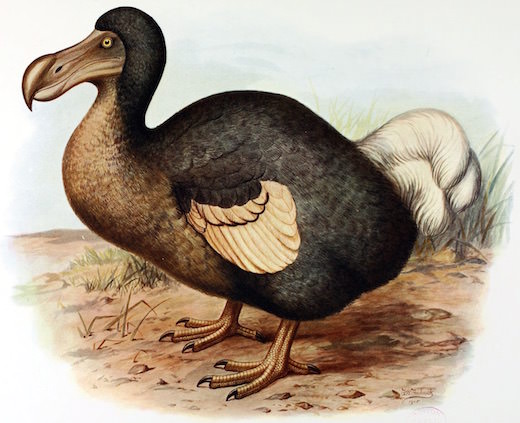Dodo

Extinct 1662
The Dodo bird is no longer in existence, but its appearance has been found by looking at old fossil remains and through drawings and paintings created during its life on earth. It is thought that the Dodo stood at around 1 meter tall and weighed between 23 and 47lb. The drawn and painted pictures created show great variation with only some having been created from drawing the actual species but these show that it has plumage that was of a brown/grey colour. The feet were a yellow colour and the tail breaks off into a tuft. The head is thought to have been naked like an eagle and the beak was thought to be yellow, black and green.
The dodo ate mainly fruits and other vegetation that were digested with gizzard stones. It is thought that the dodo was not always flightless but became so through evolution as more food became readily available at ground level and that predators were in the minority.
Many people felt that the dodo was not a real creature but a mythical one which was proved wrong by reading through many accounts of people encountering. The first record in history which has proved invaluable was those written by sailors during 1598. The last time it was noted to have been seen was in 1662. In the 17th century there was proof of the dodo’s existence including a head that had been dried and brought over to Europe. This is the only dodo soft tissue sample remaining in the world! Other samples are in fossil form and were collected in Mauritius. The Alice in Wonderland story brought worldwide recognition of the creature and today it is still used as a symbol of extinction and even a mascot for many sports teams.
Habitat
As the extinction of the dodo has made it difficult to find out which was the preferred habitat remaining evidence is the closest way to find out. It is thought that they lived in wooded and drier areas near to the coat of Mauritius. There have also been fossil findings in caves in areas of highland which also indicates they lived in mountain areas at some point.
Reason for extinction
The dodo for most of its lifespan had very few predators which meant it had no fear of humans when eventually discovered. Sailors often captured them and used them for investigation and were thought to have also been eaten by slaves and fugitives back in the 17th century. Although the area they lived in was not inhabited by more than 50 people more animals were brought into the area for food and domestication which meant that the dodo’s nests were plundered. The nests were also destroyed to allow habitation of humans in the forests they once lived. Although hunting played some part in their extinction it is though that humans moving into their area of habitation to be the most damaging to their species. Some were given as gifts and sent to other areas where they did not have the environment they needed to survive and as they were often gifted as one rather than in pairs they were not able to breed.